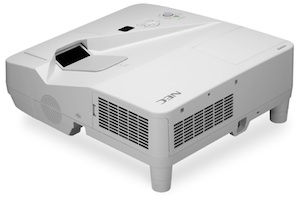NEC Intros Ultra-Short-Throw Interactive Projector Bundles

The new NEC UM-series projectors offer up to WXGA resolution and a 3,300-lumen brightness rating. |
This January NEC will ship two new ultra-short-throw LCD projectors, both to be available with in bundles that provide interactivity using the company's eBeam technology.
The UM330X is an XGA-resolution projector (1,024 x 768 pixels) with a brightness of 3,300 lumens and a contrast ratio of 3,000:1. The UM330W has a native WXGA resolution (1,280 x 800 pixels) but is otherwise nearly identical to the UM330X.
Both are designed for extremely short throw distances, as little as 17.64 inches to produce a 58-inch (diagonal) image on the UM330U and a 61.5-inch image on the UM330X. They're also designed to be used with the optional NP02Wi eBeam interactive system, which allows for functionality similar to that of an interactive whiteboard using a small receiver and compatible stylus.
Other features include:
- 1.4x zoom;
- Wired and optional wireless LAN;
- USB viewer;
- Closed captioning support;
- Integrated wall color correction;
- Automatic or manual keystone correction ±10 degrees;
- Carbon savings meter;
- Virtual remote; and
- Integrated 16 watt speaker.
AV inputs includedual HDMI, RGB (mini D-sub 15-pin), S-video, composite video, mic, and stereo minijack. AV outputs include monitor out (mini D-sub 15-pin) and variable audio out (minijack). Networking and control ports include wired LAN (RJ-45), optional wireless LAN, three USB ports, RS-232, IR, and DDC/CI. The units measure 16.9" (w) x 23.3" (d) x 4.4" (h) and weigh in at 12.6 pounds.
The UM330X and UM330W will both be available in January. The XGA UM330X will run $1,099 as a standalone unit or $1,299 with a wall mount bundle. The WUXGA UM330W will sell for $1,318 individually or $1,518 with a wall mount bundle. The eBeam NP02Wi sells for $489. Additional details can be found on NEC's projector portal.